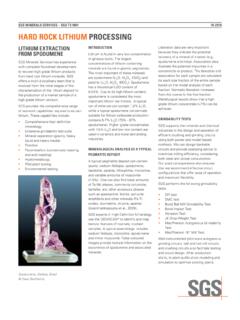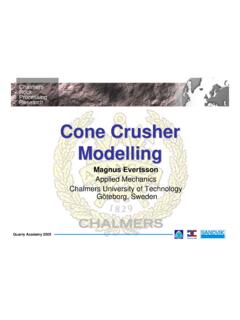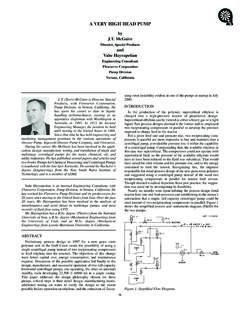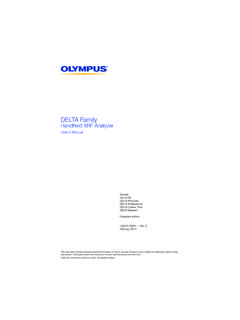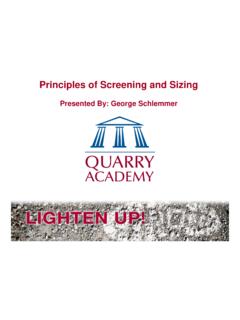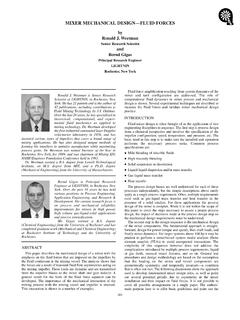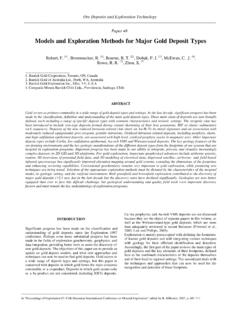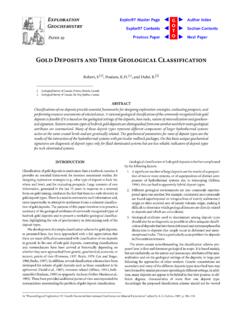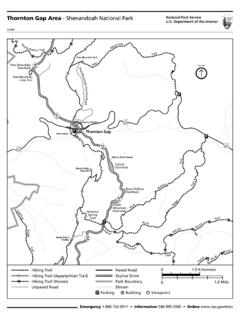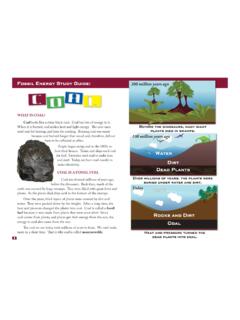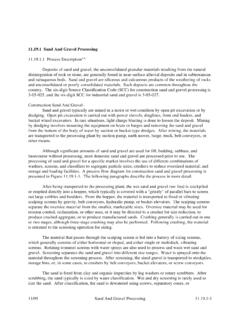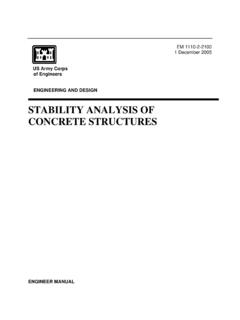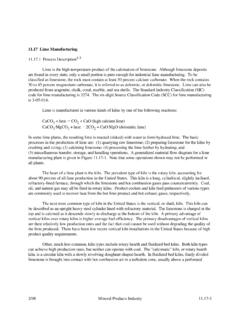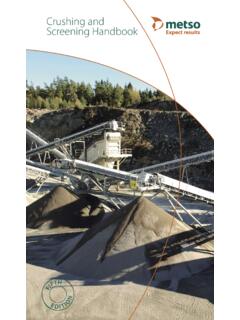Transcription of Crushing Plant Design and Layout Considerations
1 1 Crushing Plant Design and Layout Considerations Ken Boyd, Manager, Material Handling, AMEC Mining & Metals , Vancouver, BC ABSTRACT In mining operations, the Layout of Crushing plants and ancillary equipment and structures is a crucial factor in meeting production requirements while keeping capital and operational costs to a minimum. This paper addresses the critical Design parameters as well as the consideration of ore characteristics, geographical location, climatic conditions, expected operational life, expansion potential, safety, environment, and operability and maintainability. INTRODUCTION The fundamental goal for the Design of a Crushing Plant is an installation that meets the required production requirements, operates at competitive cost, complies with today s tough environmental regulations, and can be built at a reasonable price despite the rising costs of equipment, energy and construction labor.
2 The following industry trends must be taken into account: Equipment suppliers are offering ever-larger primary crushers, with 1,800 mm (72 in) gyratories expected soon, as well as secondary and tertiary machines of up to 3,000 mm (120 in). Rising energy costs are causing owners to increase the integration of mine and mill Design , so that they can identify ways of reducing overall electrical power consumption. Electronic control of crusher discharge opening and feed rate. With adjustment of a crusher s discharge opening, as the production continues through an on-line coarse size analysis of the crushed product (digital image analyses). Dance, A. 2001) More attention is being paid to the impact on Crushing circuit Design caused by variations in ore characteristics, size distribution, moisture content, ore grade and climatic conditions.
3 Operators have always dreamed of reducing the need for Crushing equipment; when SAG mills were first introduced, it was hoped that they would eliminate secondary and tertiary circuits. As it turned out, designers are now adding secondary or pebble crushers to SAG circuits, on both greenfield and retrofit projects, to increase feed rate to the SAG mill. In other words, Crushing plants , from primary to quaternary circuits, are here to stay. There are three main steps in designing a good Crushing Plant : process Design , equipment selection, and Layout . The first two are dictated by production requirements and Design parameters, but the Layout can reflect the input, preferences and operational experience of a number of parties. These can include the owner s engineering staff, safety personnel, operations and maintenance personnel, equipment manufacturers, and the engineering consultant.
4 Ideally, the consultant combines his knowledge and experience with an understanding of all parties needs, to provide a balanced, workable, safe and economic Plant Design . 2 Design PARAMETERS The principal Design parameters that drive Crushing Plant selection and configuration include: Production requirements Capital cost Ore characteristics Safety and environment Project location Life of mine/expansion plans Operational Considerations Maintenance requirements Climatic conditions Each of these is addressed in the sections that follow. Production Requirements The process Design criteria define the project s production requirements, and typically include those shown in Table 1. Table 1 Production requirements Process Description General Ore Characteristics Operating Schedule General Primary Crushing Fines Crushing Storage & reclaim Maximum rock size in the feed Ore types, compressive strengths and abrasion indices Ore specific gravity Ore bulk density Ore moisture, wet season Ore moisture, dry season Angle of repose Angle of withdrawal Angle of surcharge Days per year Hours per day Nominal annual throughput Mining shifts per day Crushing Plant shifts per day System availability and utilization The flowsheet specifies the nominal Design , peak production flow rate, and equipment sizing to handle those capacities.
5 Manufacturers provide ratings for their equipment, preferably based on testwork and/or experience, so a project flowsheet specifies tonnage requirements and the equipment is selected to meet or exceed the capacities. Design criteria can be calculated from a simple spreadsheet as shown in Table 2. Mine haul-truck capacity is an important factor at primary crusher installations, because it is cost-effective to integrate truck cycle time at the crusher station with mine/shovel operations. If a primary crusher dump pocket is undersized and unable to handle the mine s trucks, then operators must slowly meter the ore into the receiving hopper. 3 Table 2 Production Requirements - Typical Example: 60 x 89 primary crusher & mill feed conveyor system Operating schedule calculation - for 3 x 8 hours per shift Days per year 365 Tonnes per year 32,850,000 Metric tonnes per day 90,000 TOTAL TIME AVAILABLE 8,760 Hours per year UNPLANNED DOWNTIME (Subract planned or known downtimes) Industrial 0 Electrical - grid 24 Weather 48 Holidays 0 Major scheduled maintenance 416 1x 8 hr maintenance shift /wk Crusher maintenance 78 1 concave change box 1, 2 months changes 24 x 2 Minor scheduled maintenance 0 Shift changes 183 10 minutes/shift Total lost time 749 PRODUCTION TIME 8,011 Hours per year (Time system is available)
6 System availability percentage 91 Production time/total time UNPLANNED DOWNTIME (Subtract unplanned downtimes) No ore 401 5% of production time (8 hrs/wk no trucks delivering ore or other reasons) Crusher plug 160 2% of production time Chute plug 200 of production time Stockpile full 80 1% of production time Safety switch 200 of production time Metal on belt 52 Approx. 1 hr/wk Belt repair 240 3% of production time Electrical 200 of production time Mechanical Repair 200 of production time Others 0 Subtotal Unplanned Downtime Hours 1,734 RUN TIME (Operating Time) 6,277 Prod.
7 Time minus unplanned downtime Total yearly downtime 2,483 Planned and unplanned hours System utilization % 78 Run time/prod. time Average hours per shift Hours per day/3 3 shifts, hours Utilization % x 24 hrs System availability % 72 Runtime hours/total time available NOMINAL OPERATING RATE 4,808 90,000/hours in 3 shifts (Average tonnes per hour) Conveyor Design rate - tph 5,769 ( * operating rate) 20% factor added for conv. selection 4 Capital Cost Direct Costs. The largest primary gyratory crushers cost US $2 million or more, while overall Crushing Plant costs can be as high as $18 million. It s necessary therefore to estimate crusher installation costs based on equipment costs plus the following direct costs, including construction contractor indirects: Earthworks Mechanical Concrete Electrical Structural steel Instrumentation.
8 Architectural Indirect Costs. Indirect costs can fall within a range of 40 to 60% of the direct costs, and include: Construction indirects Startup and commissioning Construction equipment Freight Spare parts/first fill Taxes/duties Engineering, procurement and construction management (EPCM) Owner s costs (relocation, hiring and training personnel, permits, licensing fees, etc). In addition to the above, a contingency to cover unforeseen costs will be in the range of 10 to 20% of the sum of the direct and indirect costs. The designer must be aware of the project-specific costs of all such elements, so that he can monitor costs and promote methods of reducing total installation costs. In some locations, for example, labor and material costs could make a gabion wall more expensive than a poured concrete wall, which has minimal structural backfill.
9 Ore Characteristics Ore characteristics are a critical element in both crusher selection and Plant Design . Dry ores require greater provisions for dust suppression and collection, including dust enclosures around screens, sealing on conveyor skirts, and vacuum and wash-down systems. Wet, sticky ores can plug chutes, reduce surge capacity, and decrease the live storage capacity of bins and silos. To address this problem, chutes must be easily accessible for clean-up, and large feeder openings must be provided for bins, silos and tunnels. If it is practical to obtain representative ore samples, it is prudent to have testwork conducted to establish ore flow properties, which will influence Design parameters. At virtually all mines, ore characteristics change over time, and it can be costly to Design in the optimal flexibility required to handle such changes.
10 Some owners stipulate that initial capital investment be kept to a minimum, with Design modifications paid for out of the operating budget. This is not always easy to achieve. Safety and Environment Safety must be designed into all mining facilities. North American mines must comply with local and national regulations such as OSHA, MSHA, the Mines Act and the WCB. The modern Plant includes safety guards around all moving equipment, and emergency pull-cords on both sides of any conveyors with personnel access. The maintenance department and safety officer must keep these safeguards in working order. Ongoing safety training of Plant personnel is imperative, and is considered to be one of the most vital and monitored feature of most mining operations. 5 Dust emissions must comply with the latest regulations for the jurisdiction. Designers must make provisions for the installation of dust abatement, suppression or collection equipment.
